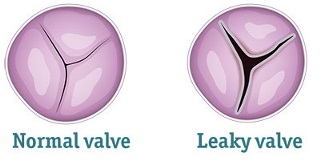Tricuspid Regurgitation
What is the tricuspid valve and tricuspid regurgitation?
Your heart has four rooms or chambers. Each is separated by a valve or doorway. The tricuspid (pronounced try-CUSS-pid) valve is located between the two right chambers of the heart. Its job is to control the flow of blood from the top room (the right atrium) and the bottom room (the right ventricle). It opens when your heart relaxes and closes when it contracts to keep blood moving forward into the lungs.
Tricuspid regurgitation – also called a leaky tricuspid valve – is one type of heart valve disease. It occurs when the thin flaps or leaflets of the valve don’t close tightly enough.

When this happens, blood can seep backward (into the right atrium) with each heartbeat. This means the heart has to work a lot harder to move blood through the valve and to the lungs. Because the heart is working overtime, it can also make it more difficult to do the things you want to do.
The condition often gets worse over time. That’s why it’s important to see a doctor with special training in treating heart valve problems. Because it usually occurs at older ages and can act like other diseases, tricuspid regurgitation can be easily missed.
Early monitoring and treatment can help stay ahead of other heart issues that can result, including heart disease and a rapid, uneven heartbeat (atrial fibrillation). Read on to learn more.
- Last Edited 12/04/2024
Featured Tools
Patient Voices
CardioSmart is supported in part by Abbott.
